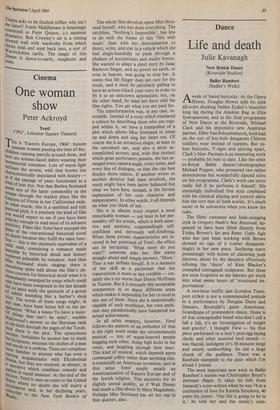Dance
Life and death
Julie Kavanagh
New British Dance (Riverside Studios) New British Dance (Riverside Studios) Ballet Rambert (Sadler's Wells) Ballet Rambert (Sadler's Wells)
Aweek of bared buttocks. At the Opera House, Douglas Howes split his pink all-overs ducking Deidre Eyden's beautiful long leg during the Alaskan Rag in Elite Syncopations; and in the final programme of New Dance at the Riverside, Michael Clark and his impressive new American partner, Ellen Van Schuylenburch, both had on the sort of key-hole dungarees Chinese toddlers wear instead of nappies. But ya- boo buttocks, V-signs and spitting apart, Clark's New Puritans is an interesting work — probably his best to date. Like the other ex-Royal Ballet dancer/choreographer Michael Popper, who presented two rather monotonous but wonderfully danced solos on this programme, Clark's work can never really fail if he performs it himself. His stunningly individual free style combined with his classical placing and control allow him the very best of both worlds. It's much easier to be subversive when you know the rules.
The filmy costumes and limb-swinging style in Gregory Nash's Not Resolved, ap- peared to have been lifted directly from Trisha Brown's Set and Reset. Gaby Agis who has just been working with Brown showed no sign of it (rather disappoin- tingly) in her new piece. Surfacing starts promisingly with noises of clattering junk (thrown about by the dancers) effectively echoing the 'decor' of Kate Blacker's crumpled corrugated sculptures. But these are soon forgotten as the dancers get stuck into what seems hours of 'structured im- provisation'.
A two-hour traffic jam (London Trans- port strike) is not a recommended prelude to a performance by Douglas Dunn and Dancers, Riverside's guest Americans. Grandpapa of postmodern dance, Dunn is of that conceptualist breed who don't call a fall a fall, it's an 'investigation of weight and gravity'. I thought View — his first piece performed to a hen's post-egg-laying clucks and other assorted bird sounds was flaccid, indulgent (it's 50 minutes long) and utterly unabsorbing. So did a large chunk of the audience. There was a Rawhide stampede to the door which I'm afraid 1 joined.
The most important new work in Ballet Rambert's season was Christopher Bruce's Intimate Pages. It takes its title from Janacek's score written when he was 74 as a confession of love for Kamila StOsslova, 40 years his junior. 'Our life is going to be in it,' he told her and the music's com- memoration of episodes, impressions and changing moods has been vividly ar- ticulated in the dance. The two casts, Frances Carty and Albert van Nierop; Lucy Burge and-Mark Baldwin, were originally to have been on stage at the same time — an interesting idea as both couples explore very different facets of the central love story. While van Nierop and Carty bring out the pathos of the biographical theme — `To love that well, which thou must leave ere long' — Burge and Baldwin, despite his silver-sprayed hair, make theirs a story of youthful passion cut short by death. Each version seems the right one because the story behind Bruce's ballet is submerged and inexplicit enough to be universal. The lullaby in the music alluding to the birth of Kamila's son becomes a mimed cradling motif in the dance but this dissolves so quickly into something else that you're not certain whether it was there or not. Similar- ly, the couple's encounter with four (small) dancers leaves you guessing. Are the two girls who waylay the man his own children or their spirits (Janacek's two children died young)? At the end the quartet become more sinister as they part the man from the woman and lead him to his death. Bruce's choreography for these phantom children is quite superb: quick, airy and full of laughter, his movements make them as in- corporeal as the children in Kipling's They. Their repeated folkdance motif is made to seem more relentlessly, heartlessly carefree the closer the man is to his death.
Whereas Bruce's interplay of folk and contemporary dance styles is there to make a dramatic point (in Concertino too) Robert North's combination of flamenco and jazz dancing in Entre dos Aguas — with amplified guitars providing an equivalent musical pastiche — appeared gimmicky. `Spanish Night at Crossroads Motel,' my companion muttered. North's other new work, Colour Moves, is zany and decorative enough but its effect lies in the contrast of costume colours against Bridget
Riley's backcloths, not in the choreography. The movement makes little reference to Riley's structures and vice ver- sa: despite a good deal of scrutiny and eye screwing, the stripes refused to perform.
Glen Tetley also takes the work of a painter, Oskar Kokoschka, as his starting point. If Murder Hope of Women had modelled itself only on Kokoschka's il- lustrations to his play (bare-breasted Lucy Burge and Albert von Nierop with his shorn head and doleful big eyes look remarkably like the figures in the drawings) the ballet might have worked. Tetley's mistake was to use the text. Not even the vocally powerful, sphinx-ish Burge could prevent the sniggers that Kokoschka's comically cosmic and comically bathetic language provokes. It came as a relief to discover that the voices in Richard Alston's new work, Voices and Light Footsteps, belong to the singers. The score is a selection of Monteverdi's Scherzi Musicali and Madrigals and Alston, while not providing the exact rendering of the words peculiar to the madrigal, follows the
composer very closely. The last song, 'In- terotte speranza', in which two tenors sing of a spurned lover who despairs and yet still desires is interpreted by Alston as a slow love duet for two men. The effect is elo- quent and unembarrassing because Alston recreates exactly the erotic yet plaintive at- mosphere of the music. I look forward to seeing this work again.











































 Previous page
Previous page